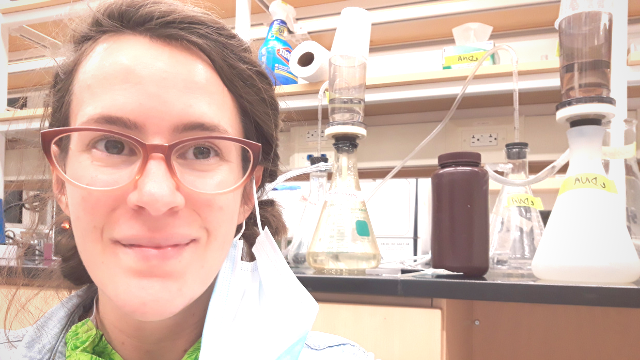
Meet Maine-eDNA: Sharon Mann, Graduate Research Assistant
by Jane Horovitz, EPSCoR Student Writer
Sharon Mann did not come from a scientific background or an academic family. After attending a small private college for a short amount of time and studying humanities fresh out of high school, Mann dropped out and moved to Alaska instead. There, she worked in two fishing industry positions and befriended a community of university students studying environmental science and outdoor education.
“Higher education was never exactly something I thought I could do or assumed I could attain,” Mann says. “And then I met these people and I realized that I could actually go to school and do something even with no background in science whatsoever.”
So Mann went back to community college, and started rebuilding her education from the ground up. Now she’s come full circle — working with fish again and taking every opportunity she can find to keep learning; such as joining the Maine environmental DNA (Maine-eDNA) program.
Before Mann decided to pursue a Ph.D. in the University of Maine’s school of Marine Sciences as a part of Maine-eDNA, she was researching invasive aquatic plants in Maine for her Masters at the University of Southern Maine, tying her job at the 7 Lakes Alliance in with her research. Along with Researcher Lucas Bernacki at St. Joseph’s College, Mann has been conducting micro-satellite research on the invasive aquatic plant, variable milfoil (Myriophyllum heterophyllum). She was interested in looking at the specific infestations that she managed through her job to see if there was a colony population, evidence of multiple introductions, or evidence of sexual reproduction occurring. Mann hopes to tie up this research before she starts her Ph.D. with the Maine-eDNA program in January 2021.
With the guidance of her three advisors — Karen Wilson at the University of Southern Maine, Michael Kinnison at UMaine, and Gerry Zegers at UMaine Machias — Mann will be studying ecosystem response to alewife restoration. She will help wrap up current research at Highland Lake in Windham, Maine focused on lower trophic level responses to alewife reintroduction, and expand the research to lakes throughout Maine.
Mann will be installing sediment traps in a variety of water bodies in Southern and Central Maine, and extracting eDNA from new sediment coming down the water column. She will be working alongside fellow Maine-eDNA Ph.D. candidate, Grayson Huston, who is researching paleo sediments and mapping out the history of alewife restoration.
“My contribution will be looking at current sediment composition and what is going on in the water body, currently, to help [Huston] calibrate his historical mapping,” Mann explains.
While Mann is on the lakes collecting information for sediment calibration studies, she will also be studying how alewife restoration is impacting zooplankton, algae, and other small organisms that live in water bodies. Algal blooms in Highland Lake began around the same time alewife reached large numbers in the lake.
“There are a lot of fingers being pointed saying ‘it’s the alewife’s fault’ but not a lot of research actually shows that as being a fact,” Mann says. “It’s just two things that happened to occur at the same time.”
Mann’s work will help co-advisor Wilson understand what is happening in Highland Lake, and expand the research to a diversity of lakes and ponds. Wilson’s latest hypothesis is that the Highland Lake ecosystem was adjusting to the alewives being reintroduced. With a new zooplankton predator present, the zooplankton aren’t grazing as much on cyanobacteria and other algae. But in the past couple of years, Highland hasn’t bloomed. Therefore, Wilson and Mann believe that the algae blooms were just a little “hiccup” in the ecosystem, which is beginning to stabilize. The many years of data in Highland Lake will allow Mann to look at the long term effects of alewife reintroductions on the ecosystem, and expand the work to other lakes.
Mann is excited to continue doing research that involves the water and to get back into working with fisheries, since on an ecosystem level, fish support so many other organisms. She also feels that the Maine-eDNA program provides a unique opportunity to conduct research that matters and will be seen by Maine’s communities.
“It’s so much easier to explain why I’m researching this to a non-scientist because it ties into Maine’s economy and tourism,” Mann points out. “It feels like I’m doing something that really matters and it can reach more people than just this isolated bubble in academia.”
In the future, Mann hopes to stay in research with an end goal of being a part of a research team or leading her own research at a lake association.
